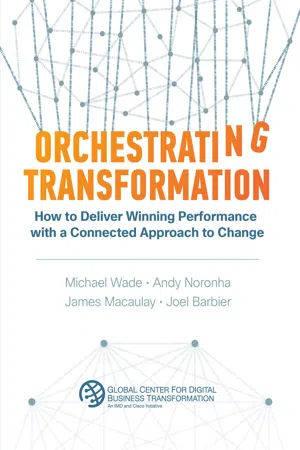
Orchestrating Transformation
How to Deliver Winning Performance with a Connected Approach to Change
- English
- ePUB (mobile friendly)
- Available on iOS & Android
Orchestrating Transformation
How to Deliver Winning Performance with a Connected Approach to Change
About this book
Company leaders feel the urgency to transform their organizations in the face of digital disruption. New rivals are digitizing whatever can be digitized to attack incumbents’ value chains, gaining marketshare, eroding margins, and wreaking havoc to the competitive landscape in virtually every industry.
For large and midsized companies, the imperative to transform is clear. How to transform is another matter.
The hard truth is that despite leaders’ best efforts, and billions spent in pursuit of digital transformation, the vast majority of organizational change programs fizzle, falling well short of their expected impacts. But organizations can ill-afford for their transformation programs to flop. Failed transformation programs put incumbents behind the eight ball when it comes to dealing with disruptive competition.
With this important new book, Orchestrating Transformation: How to Deliver Winning Performance with a Connected Approach to Change, the team at the Global Center for Digital Business Transformation, an IMD and Cisco initiative, set out a new prescription for getting transformation right.
The piecemeal strategies and pilot projects that are hallmarks of conventional transformation programs are hopelessly inadequate for the intricate, sprawling organizational environments found in most companies.Transformation practitioners need a different mindset and a new approach to executing change that can handle the complexity and scale of today’s market leaders. Orchestration—"mobilizing and enabling so as to achieve a desired effect”—paves the way for a new, more holistic view of organizational resources and how they work together to drive change synergistically.
The follow-up to 2016’s award-winning Digital Vortex, the book is packed with quantitative and qualitative insights from years of applied research and engagement with executives around the world.
A unique and indispensable guide for practitioners, Orchestrating Transformation moves past traditional change management doctrine to show how a connected approach to change can change everything.
Frequently asked questions
- Essential is ideal for learners and professionals who enjoy exploring a wide range of subjects. Access the Essential Library with 800,000+ trusted titles and best-sellers across business, personal growth, and the humanities. Includes unlimited reading time and Standard Read Aloud voice.
- Complete: Perfect for advanced learners and researchers needing full, unrestricted access. Unlock 1.4M+ books across hundreds of subjects, including academic and specialized titles. The Complete Plan also includes advanced features like Premium Read Aloud and Research Assistant.
Please note we cannot support devices running on iOS 13 and Android 7 or earlier. Learn more about using the app.
Information
- Scale. Companies are awash in huge volumes of “things that need to be managed”: tasks, budgets, planning cycles, organizational changes. In addition to the number of things to be managed, there are also many different things that must be managed: processes, data, systems, assets, structures, and people. Companies face an acute case of information overload as well. The data is not merely “big” in volume, but also high in variety.
- Interdependence. The things that need to be managed are interrelated, and the effects from any one action are felt throughout the organization in ways that aren’t easy to predict.
- Dynamism. The things that need to be managed, and the environments (market, regulatory, etc.) in which they operate, are constantly evolving. The need to do things differently is a constant competitive reality. Simply put: things change a lot.

Table of contents
- Cover Page
- Praise for Orchestrating Transformation
- Title Page
- Copyright Page
- Dedications
- Table of Contents
- INTRODUCTION The Context for Transformation
- CHAPTER 1 The Transformation Dilemma
- CHAPTER 2 Understanding Guiding Objectives
- CHAPTER 3 Establishing Guiding Objectives of a Transformation
- CHAPTER 4 The Transformation Orchestra
- CHAPTER 5 Orchestration Competencies
- CHAPTER 6 Organizing for Orchestration
- CONCLUSION Orchestration in Action
- Acknowledgments
- APPENDIX 1 Digital Disruption Diagnostic
- APPENDIX 2 Organizational Resources by Instrument
- APPENDIX 3 Resource Capability Assessment Worksheet
- APPENDIX 4 The Orchestrator's Cheat Sheet
- Endnotes
- Index
- About the Global Center for Digital Business Transformation
- About IMD and Cisco
- About the Authors